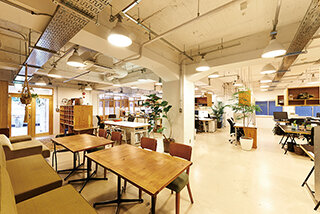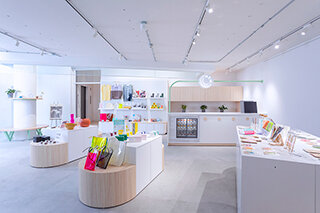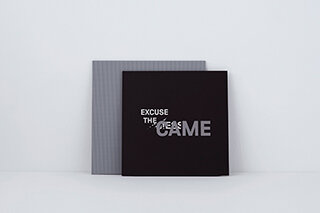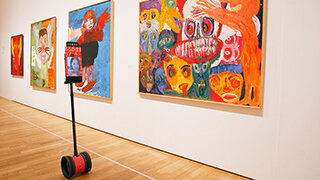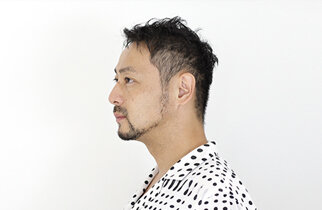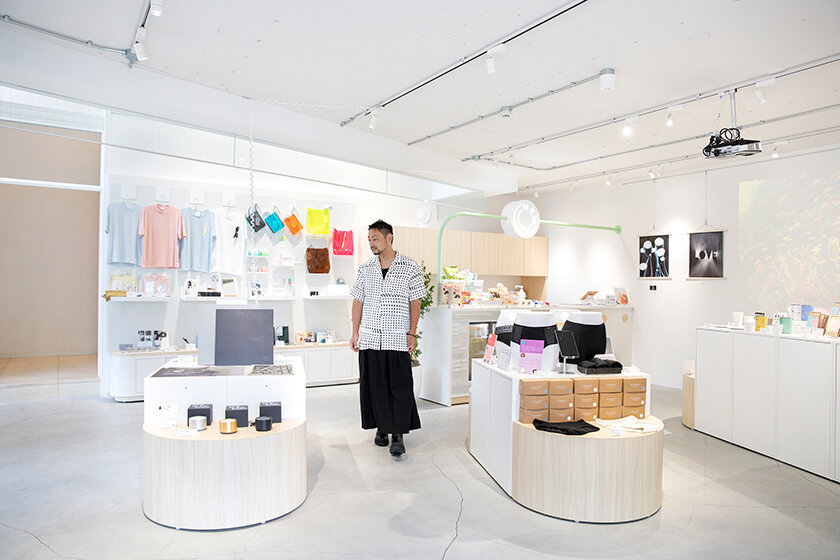
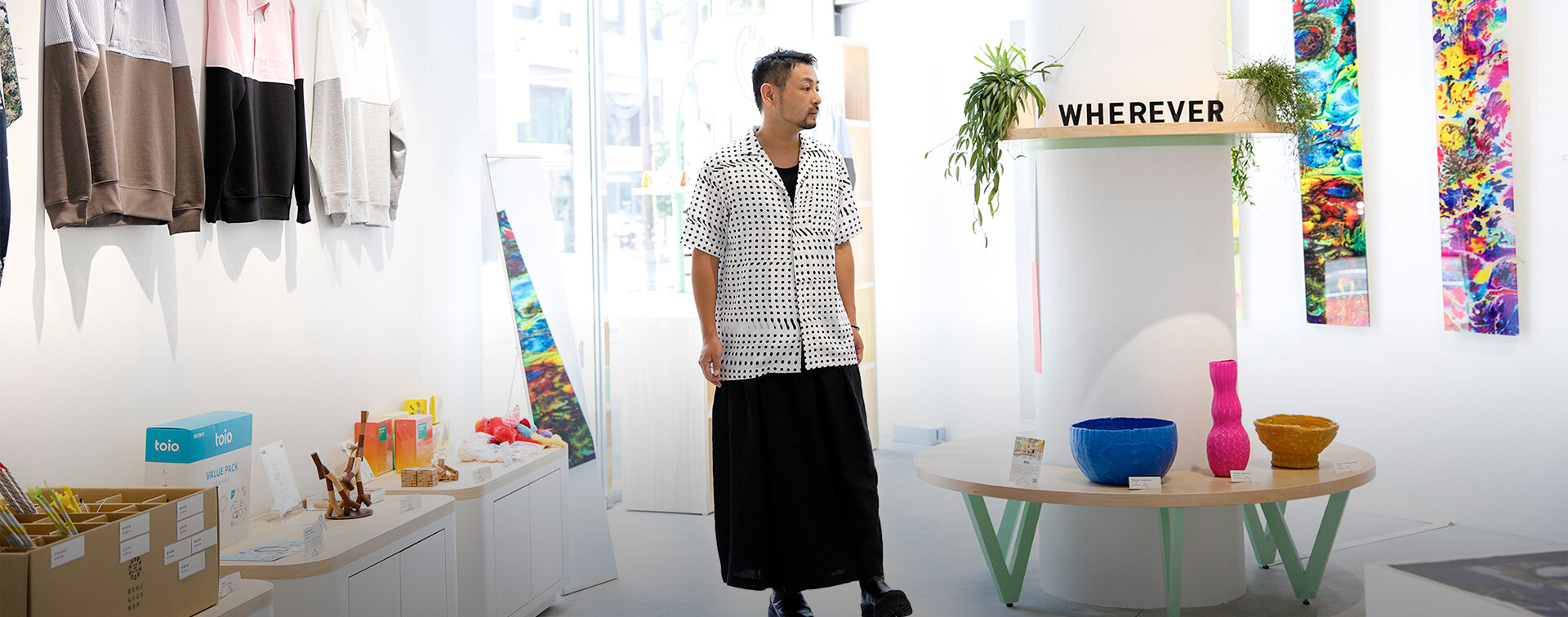
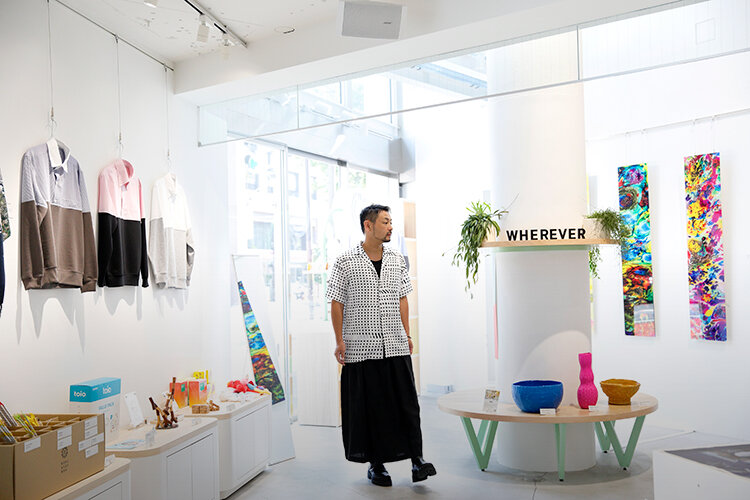
INTERVIEW
120
Yusuke TominagaProducer/CEO
To Have an Autonomous Robot Roam a Town with Mural Art
The attempt to bring a totally different kind of culture to Roppongi
Yusuke Tominaga, CEO of the creative studio Whatever Inc., moved his office from Shibuya in fall of 2019 and became a "resident" of Roppongi. His output of unique ideas continues in his new setting, grounded in a fluid team style and WHEREVER, a gathering place for studio members as well as creative freelancers and artists. We set out to examine the secret behind how Tominaga draws out creators' abilities as CEO and producer, as well as his "whatever inspires" production attitude and ability to bring those inspirations to life.
Away from the ongoing large-scale development in Shibuya to a new environment in Roppongi
Our company Whatever originally had its office in Shibuya and we ran a shared office space near Miyashita Park called HOLSTER. The main reason we moved to Nogizaka last year was the large-scale redevelopment going on in Shibuya. Shibuya is a town where creators gather, and we had about 60 tenants at the time. HOLSTER also had a gallery for artist shows and we invited all kinds of guests every month to participate in an event called the "Monthly Snack Magazine." It was a pretty exciting space, but we found out that the building was going to get torn down.
HOLSTER
A shared office space for creators founded by Whatever and Tokyo Pistol in 2014. The building it was in also housed the cafe ON THE CORNER, making it one of the iconic spots representing the creative scene in Shibuya at the time.
We initially looked for a new location in Shibuya, but it was pretty much impossible to rent any property with enough space to run a shared office at a similar price to what we had been paying before. With a certain major global IT company setting up office in Shibuya, it's clear that the town is becoming a place exclusively for big businesses that have a lot of money. We looked around Shibuya for almost a year without finding anything, but when we expanded our search a bit, we found out that this entire current building was open. So, we moved here and opened WHEREVER.
WHEREVER
An eight-story coworking building primely located just one minute away on foot from Nogizaka Station. The entire 900-square-meter-building is used to house about 70 individual creators and team members. A lounge with a full kitchen on the second floor where tenants can mingle and also serves as an event space.
The new space is a beautiful building created by an architect named Kiyoshi Sey Takeyama, completed in 1989. It has a very unique facade and an atrium inside that takes up the first three stories. Developers nowadays who prioritize floor space would never make something like that (laughs). I was taken by that sense of daring. Roppongi today has become a kind of haven for art, but the impression I get is that "luxury" art is more prevalent. In contrast, we grew as a company amidst Shibuya culture, and Whatever has offices in New York, Berlin, and Taipei. I think it would be interesting to bring a totally different kind of culture to this town.
The reason for having an offline shop in this day and age
At the end of July, we opened a specialty design shop called New Stand Tokyo on the ground floor of WHEREVER. New Stand originated in New York City, and when our CCO Masashi Kawamura established PARTY NY six years ago, he happened to meet New Stand founder Andrew Deitchman and they have been friends ever since. The name comes from New Stand being an updated renovation of old "newsstands," which are kiosks in New York City that sell newspapers and other daily goods on street corners and in subway stops. After the first location opened in Union Square Station, New Stand now has about 40 locations open in New York City and throughout the USA, presenting new items to incorporate into daily life as "a day improvement company."
New Stand Tokyo
New Stand Tokyo opened on July 28, 2020 on the ground floor of the WHEREVER building as a specialty shop that sells "general goods of the future" with the next generation in mind. The first New Stand opened in Union Square Station in 2015, and has since expanded locations throughout New York City.
New Stand Tokyo is the first New Stand location outside of the USA. The reason we decided to open it here was because the ground floor of the building had previously been used for retail, and I had always wanted a space to show the things we make and to connect with consumers. Some of our company's original products include the Lyric Speaker, which displays lyrics as it plays music, and WFH Jammies to wear when working from home. We have challenged ourselves to create all kinds of products through crowdfunding platforms such as Kickstarter. I wanted to showcase the things that we and others around us have made, but I thought simply displaying our creations would limit it to the handcrafted feel of a school festival. We needed a more appealing concept, and that's when I remembered about New Stand. When I told them about our move to Roppongi, they were very quick to move forward with the idea. We had them actually come see the building and we officially signed a license agreement for opening in Asia.
Lyric Speaker
Commercialized after receiving the Best Bootstrap Company award at SXSW 2015, this next-generation speaker displays lyrics in time with the music, embellishing the room with visible lyrics much like a favorite vinyl record jacket displayed as decor. The product is on sale through COTODAMA, a company established through joint investment with SIX and others.
WFH Jammies
Work-from-home roomwear designed and produced during the spread of COVID-19. It features a matching top and bottom sweatsuit style that switches from the chest up into a shirt that is webcam-appropriate. Created by fashion brand LOKITHO's designer Akihiko Kimura, not only is the idea behind it is brilliant, but it is also well designed and fabricated. WFH is, of course, short of "Work From Home."

A "general store of the future" that inspires imagination
Simply bringing the NY shop as-is to Tokyo wouldn't be interesting, so New Stand Tokyo operates under the concept of a "general store of the future." For example, conventional speakers only play sound, but the Lyric Speaker also displays lyrics, giving it a futuristic touch. Being "ethical" is also something of a product trend these days, but most of the products are not so common as to be called general daily goods yet. It would be nice if someday in the future, every household would have these ethical products as a new norm.
I want New Stand Tokyo to be a place for introducing those kinds of "experimental" goods, perhaps most exemplified by femtech products. "Femtech" is a portmanteau made up of "female" and technology," meaning products and devices to address challenges and issues faced specifically by women. These range from advanced technology devices that go on a pregnant mother's belly to monitor fetus vitals to old inventions like the menstrual cup, a medical grade silicone feminine hygiene device to insert into the vagina and collect menstrual fluid that actually existed for decades without widespread use.
So why would these be called "general goods of the future"? For example, menstrual pads are by far the dominant menstrual solution in the Japanese market but adding other possibilities such as absorbent underwear and menstrual cups would give people the chance to make alternative choices. These aren't products that monopolize the market. They're experimental products that have yet to become the norm. That's why they immediately jumped out at me when I was searching for "general goods for the future." The word femtech is being treated like a buzzword now, but I think once femtech products become an ordinary part of life and they're sold in drug stores and convenience stores as the norm instead of as "goods for the future," it will be a step towards alleviating the challenges associated with the well-being of women. Once that happens, femtech products will "graduate" from New Stand Tokyo and I'll have to think of a new type of product to feature.
Femtech
Technology in the form of services, software, and products developed to help solve women's health issues such as menstruation and infertility treatment. This new industry has expanded its foothold in Europe and North America, and has potential for rapid growth in other regions such as Asia and Africa.
photo:©Bloomlife
Robots journeying beyond the museum to stroll around Roppongi
Having an actual offline shop is a new challenge for us that posed a lot of difficulties. At first, we had absolutely no idea about the best way to go about displaying products. It was so bad that when we unpackaged the products we had collected for the shop, we just froze, thinking, "What do we do with all of this?" (laughs) We're still going through trial and error, adjusting the layout on a regular basis. Plus, now with COVID-19, it's hard to get customers to come in person, so we've introduced some new technology in the shop called Robot Viewing. It's a new system that uses an automated robot with a webcam. Customers can log in online and remotely control the robot to check out the shop.
Robot Viewing
In a time when actually going places is difficult due to the coronavirus pandemic, this system lets a person remotely "visit" a place online by controlling a robot at the venue from home. A maximum of five people can log in at once so that families and friends can enjoy being in a place together. They can even communicate with other people at the venue using the robot's speakers.
Robot Viewing is based on software that we used before in an exhibition called Art As It Is: Expressions from the Obscure. Recently, art museums have had to set limits on visitors and can't have the kind of crowds they wish they could have. That's why we came up with a system to let people view the art even if they can't visit in person. The original system only allowed one person to log in to a robot at a time, but this allows a maximum of five people to log in at the same time and chat while looking at the art. Think of it as kind of like a carpool. When going to see art, I think people tend to focus on each piece of artwork alone, but this software lets people enjoy chatting as well, maybe about which direction to go next or what they think about a certain piece. And it's not just for viewing art. I think it has potential for new shopping experiences or it could even be fun to take it for a stroll around Roppongi. We might know nothing about setting up an actual shop, but we do know all kinds of things about technology that we hope to make good use of to create more interactive tactics.
Loose collaboration particularly in an age where individuality is becoming more prominent
At the root of operating Whatever is the Creative Commune concept. In addition to regular employees, we have a "Co-creator system" that allows hybrid working styles for individual artists and freelancers to do their own work while also belonging to our company. We also include others we're connected with through our various domestic and global networks in a creative community of loose collaboration that we call the Creative Commune. In the basic conventional working style, an individual belongs to one company and that company finds and provides the individual with work. But that's starting to change now, with a lot more focus on the individual. This is particularly true for creators, where clients tend to name a particular individual they want to work with, and sometimes these individuals have even more influence on social media platforms than their companies do. At that point, there's hardly any reason to be part of a company at all, is there?
Meanwhile, the work is getting increasingly complex with plenty that can't be done alone as an individual. So, if strong individuality can get together and make appropriate use of an organization, that's super powerful. I want Whatever to be a place filled with the kind of individuals that people aspire to connect with. Given that, it makes sense not to limit the company's employment to regular employees and provide flexible ways of engagement. I call the different levels of individual engagement with a company "relationship layers." The president and executives at the core of the company naturally have the strongest relationship with the company. Next come the employees, then the parallel workers who are regular employees at multiple companies, and then the Co-creators who balance their freelance work with their work at Whatever. Another layer is comprised of the residents of the shared office space, who work for different companies, but all share the same space as creators. On the opposite end, we also have members who are based outside of the country but come to do their creative work at our office whenever they visit Japan. Although all of the layers have different degrees of engagement with the company, I think that we're all a part of the same big team as long as we can relate to each other as creators and strive for quality in our creations. I wanted WHEREVER to be a gathering place for people like that.
This ideology resulted from running the shared office space in Shibuya and my experience seeing how new things are born when a diverse group of creators come together. With the extra space available at WHEREVER, we can now afford to have an even more diverse gathering of people. The third and six floors house the companies that we fund. On the third floor is WTFC, a company of producers that Whatever jointly established with Tohokushinsha, who sympathized with our ideology. WTFC is also the official business operating the building (WHEREVER). On the sixth floor is BASSDRUM, a company made up solely of engineers and technical directors. Every floor of WHEREVER houses fellow creators and we do things together as a community, like holding events and workshops in the common areas or just having meals together on any given day. It's an evolved version of what we had in Shibuya.
The value of physical spaces may be dropping, but we still need a place to create
I think loose relationships that aren't too stiff are also important in business, so we make a point of not having clear-cut rules. It's the same with contracts. I believe that putting creators into a designated box means they'll never create anything beyond that box. So, I want to eliminate boundaries as much as possible and simply connect via ideas and sentiments. In that sense, I suppose "to not manage things" is my motto as the company representative. But the basis of "managing without managing things" lies in the strength of each individual, so the initial selection of personnel is very important. That's true for the members of the company of course, but there's actually a selection process for becoming a resident of the shared office space as well. We ask each applicant for a portfolio and only select individuals who maintain a certain level of quality in their creations and seem to be a good fit for WHEREVER's atmosphere. I don't think there are any other shared office spaces that involve a creator interview process, but it's hard to create with people who don't make things that demand respect, and I also want to always be excited by the things they're working on.
Especially with the coronavirus pandemic, I think the value of having a physical space is dropping compared to when we moved here. Case in point, we have had people cancel after being accepted to the shared office space, among other things. But I believe the importance of interpersonal connection still holds true. It's difficult doing everything online, so there'll always be a need to have some amount of space to get together. I think it's significant to have WHEREVER as a place for connection--a place where you go because your team is there, too.
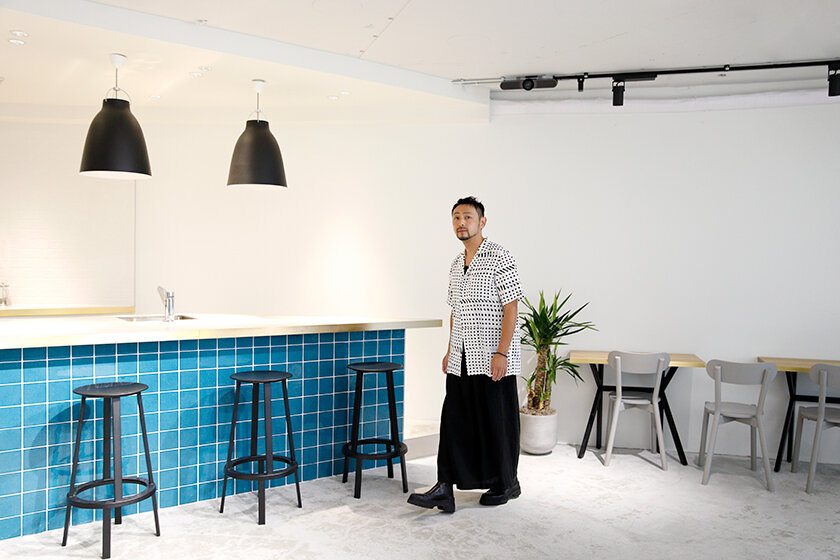
Urban identity engrained in ordinary life
If I were to do something interesting to Roppongi in terms of art or design, I'd want to paint a mural on this building's huge facade. This is partly because I want to use our Shibuya origins to change Roppongi's image of being a town for "luxury" art, and partly because I want to spice up the urban landscape a bit since a lot of the buildings around here look the same. I also want to have an autonomous robot roam around town. We're good at coming up with interactive strategies, so I feel like we might be able to do something interesting in conjunction with the museums in Roppongi as well.
In regard to towns, my favorite city in the world is Kyoto. I was born and raised in Kyoto, but it wasn't until I left that I realized what a special place it really is. It's not unusual to find companies there that have been going for 300 years, and the ideology of keeping tradition unchanged gives the city an unwavering identity. Japan in particular has no other town like it. I also like how the city's identity is engrained in the people's lives. For example, the reason that the famous Gozan no Okuribi lights bonfires on each mountain (where five mountains around Kyoto are lit in the shape of kanji characters) is so that the ancestral spirits visiting their families during the Obon festival can return to the spirit world without getting lost. It's basically a kind of religious ritual unlike other summer events like a firework show, but it's engrained as a natural part of life in Kyoto and a huge event for the city. I think that inclination is very nice.
We encourage "whatever" because we value individual motivation
I think the motivation that drives my work is my past experience of leaving a company that I established. When I was in college, I started a company called AID-DCC Inc. with a team including my older brother. I worked there for fourteen years, personally interviewed quite a significant number of people, and we had a great team going when I came up with the idea to create a new company where the spotlight was more on the individual while maintaining a good balance with the organization. But when I realized that I was about to leave a company where I had worked my heart out for fourteen years, I suddenly felt very sad. That's exactly why I decided that from then on, I wanted to create relationships that don't require a person to "leave." Of course, some say there's a point in leaving a company to establish oneself in a new stage of one's career, but I think the ideal option is for the relationship to continue in different "relationship layers," even if the relationship fluctuates between close and distant depending on the period.
We have an office in Berlin, but that wasn't really an active choice, either. An engineer I worked with was sick of not being able to get a kid into daycare in Japan and wanted to move to Berlin. So, I said "Okay, then let's set up an office there," and that was that. Similarly, we set up the Taipei office because one of our members in New York moved there after marrying someone from Taiwan.
If a company as an organization can meet the personal needs of its members, I think that's a wonderful thing. Because deciding to go to Berlin as an individual requires so much more motivation and energy than you would think. Now, if it was the company saying, "You're moving to Berlin! Tomorrow!" you'd be like, "What? Why?!" right? It's very difficult to control people's motivations, but it's not that hard for a company to provide motivated people with a place to be and work to do. That's why I persistently ask my employees and fellow creators whether they're enjoying work and whether they're unhappy about anything. Because it makes me unhappy to have people who are unhappy. What a ridiculous President, right? (laughs) Of course, there's bound to be difficult things that make you unhappy as long as you're working. But it's important to feel that there's something to enjoy or learn from despite the hardships, and people can overcome those hardships if it's something they really want to do. That's why individual motivation is always my top priority.
Editor's thoughts
Although exceptional output doesn't necessarily equal good teamwork, it's only when both are true that everyone involved ends up happy. I get the strong sense that the Creative Commune concept that producer Tominaga-san insists on is what shapes Whatever's incredible level of creativity. He has constructed layers out of a desire to "create relationships that don't require a person to leave." Perhaps the kind of loose collaboration he proposes is something society today needs beyond the scope of the creative industry. (text_ikuko hyodo)
RANKING
ALL
CATEGORY




